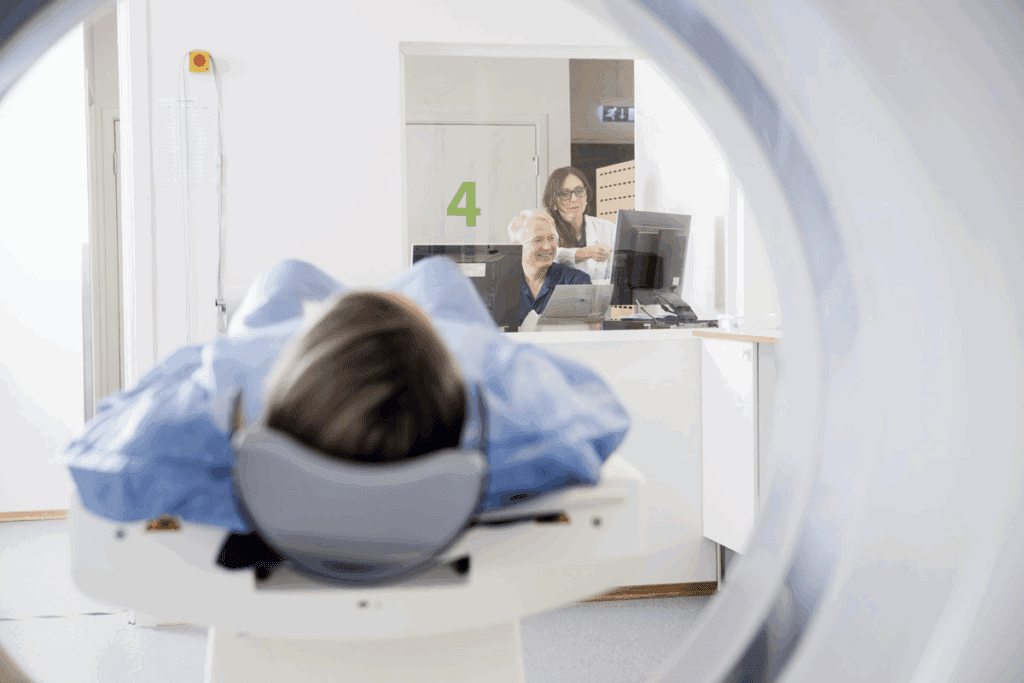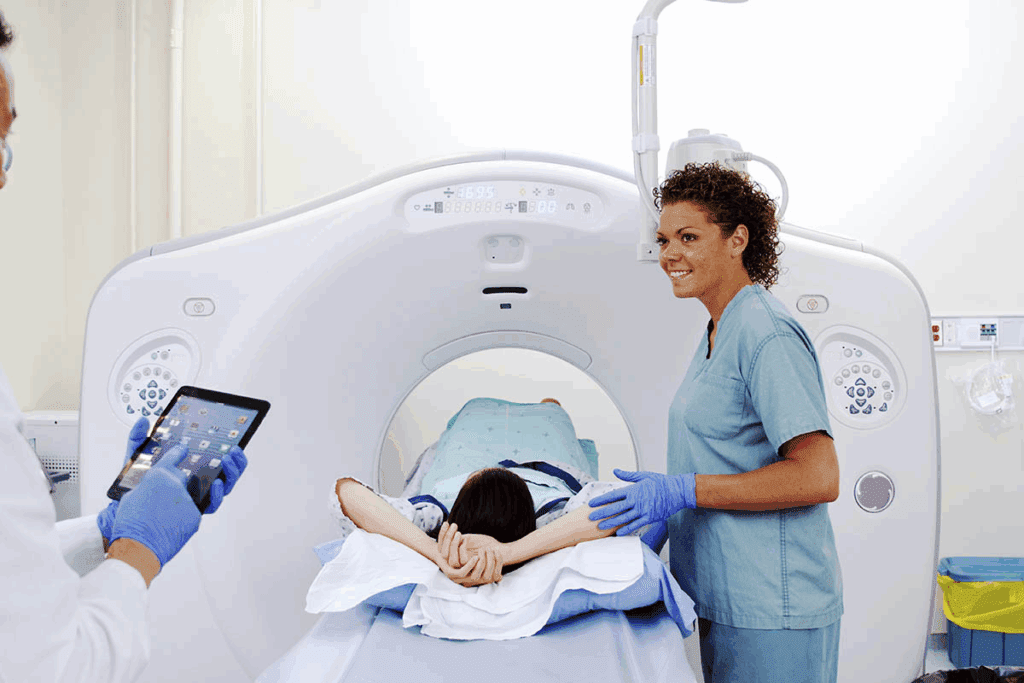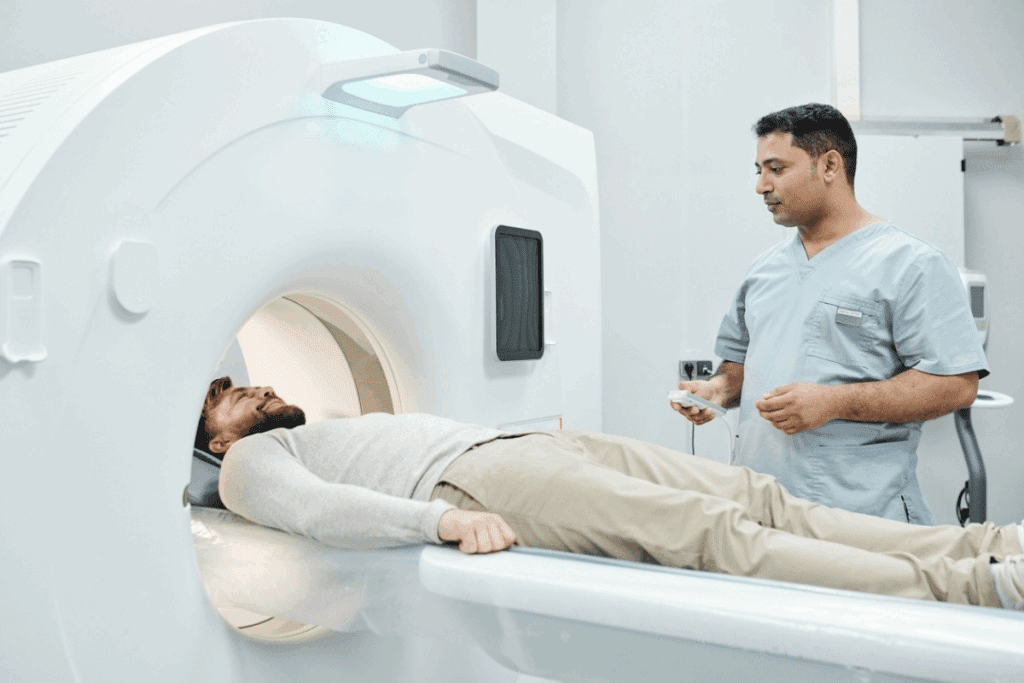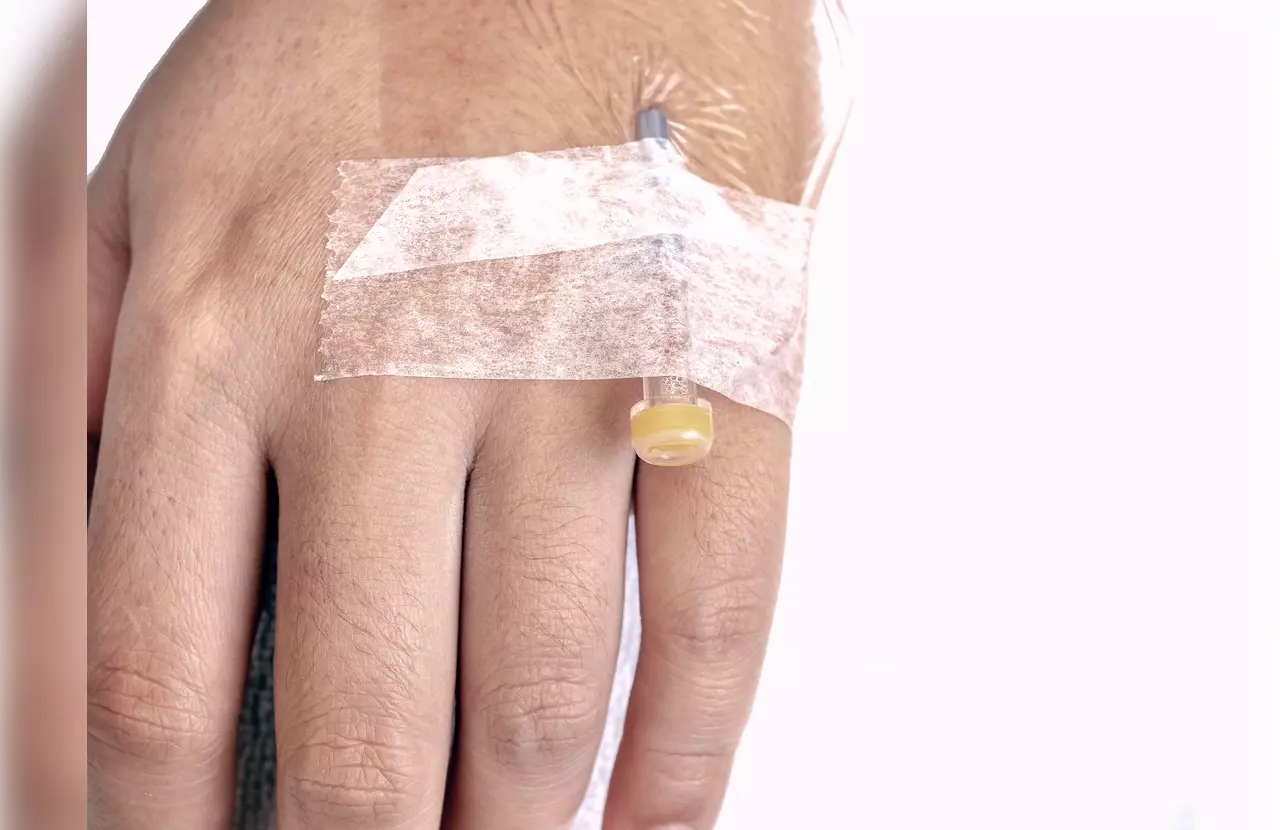Last Updated on November 27, 2025 by Bilal Hasdemir

Nearly 2 million PET scans are done every year in the United States. They help find and track health issues, like cancer. But, some people feel sick after getting one.
Knowing about the side effects of a PET scan can ease worries. Even though PET scans are mostly safe, the radioactive tracer used can cause some problems.
Key Takeaways
- PET scans are a key tool for diagnosing health issues.
- Some people might feel bad after a PET scan.
- Learning about PET scan side effects can help prepare you.
- The tracer used in the scan can lead to some issues.
- Knowing what to expect can make patients feel better.
What is a PET Scan and How Does it Work?

A PET scan, or Positron Emission Tomography scan, is a high-tech imaging method. It uses radioactive tracers to see how the body works. This tool is key in medicine for spotting and treating health issues.
The Basic Principles of PET Imaging
PET imaging catches the body’s metabolic activity. It uses a radioactive tracer injected into the blood. The tracer builds up in the body, and a PET scanner picks up the signals, making detailed images.
First, the patient gets ready by fasting. This helps the tracer work right. Then, the tracer is given, and the patient goes into the PET scanner. The scanner moves around, taking pictures from all sides.
Radioactive Tracers and Their Function
Radioactive tracers send out positrons, which meet electrons and create gamma rays. The PET scanner catches these rays. The most used tracer is Fluorodeoxyglucose (FDG), a sugar molecule with a radioactive tag.
Places with lots of activity, like cancer cells, grab more FDG. This makes them show up clearly on the scan.
| Tracer Type | Application | Characteristics |
| FDG (Fluorodeoxyglucose) | Cancer detection, neurological disorders | Highlights areas of high glucose metabolism |
| Other tracers (e.g., Oxygen-15, Nitrogen-13) | Cardiac and neurological studies | Various applications based on the tracer’s properties |
The tracer used depends on what the scan is looking for. Scientists keep working on new tracers to make PET scans even better.
The Purpose and Importance of PET Scans in Medical Diagnostics
PET scans are key in medical diagnostics. They give vital info for diagnosing and treating many conditions. Their detailed look into the body’s metabolic processes is very useful in different medical areas.
Cancer Detection and Staging
PET scans are vital for cancer detection and staging. They help see how far cancer has spread in the body. A full body PET scan for cancer is great for figuring out the cancer’s stage. This is key for picking the best treatment.
The use of FDG (Fluorodeoxyglucose) in PET scans shows metabolic activities in the body. It spots areas with abnormal glucose uptake, often seen in cancer. This is very helpful in managing whole body pet scan cancer cases, where knowing the cancer’s spread is vital.
| Cancer Type | Role of PET Scan | Benefits |
| Lymphoma | Staging and assessing treatment response | Accurate staging, guiding treatment decisions |
| Lung Cancer | Detecting metastasis, assessing tumor activity | Improved treatment planning, monitoring disease progression |
| Breast Cancer | Assessing tumor aggressiveness, detecting metastasis | Enhanced diagnostic accuracy, personalized treatment plans |
Neurological and Cardiac Applications
PET scans also help a lot in neurological and cardiac diagnostics. In neurology, they help find and manage diseases like Alzheimer’s. They look at brain activity and find areas with low metabolic function.
In cardiology, PET CT cardiac scans check heart function and how well the heart muscle works. This info is key for patients thinking about heart procedures or those with heart failure. It helps doctors decide on treatments and predict outcomes.
PET scans are very versatile in medical diagnostics. They give detailed metabolic info. This helps in early detection, diagnosis, and management of diseases. It leads to better patient outcomes.
Common PET Scan Side Effects: What to Expect

It’s important for patients to know about possible side effects from PET scans. This helps manage their expectations. While PET scans are useful, some people may have negative reactions.
Immediate Physical Reactions
Some people might feel immediate physical side effects after a PET scan. These can include:
- Fatigue or feeling weak
- Nausea or headache
- Dizziness or reactions at the injection site
Medical experts say these reactions are usually mild and short-lived. But, it’s important to watch how your body reacts and tell your doctor if symptoms get worse.
Psychological Effects
The mental impact of a PET scan is significant. Some patients might feel anxious or stressed about the scan results or the process.
“The anxiety associated with awaiting PET scan results can be significant for some patients.” – Radiologist
Talking to your healthcare team about your worries can help reduce any mental distress.
Duration of Common Side Effects
Most side effects from PET scans don’t last long. For example:
| Side Effect | Typical Duration |
| Fatigue | A few hours to a day |
| Nausea | Less than 24 hours |
| Headache | Variable, but usually resolves within a day |
Knowing how long side effects last can help plan your recovery and daily life after the scan.
Understanding Why PET Scan Side Effects Occur
It’s important to know why PET scan side effects happen. PET scans are great for finding health issues, but they can cause side effects. These can be mild or serious.
Physiological Response to Radioactive Tracers
PET scans use radioactive tracers like FDG (Fluorodeoxyglucose). These tracers help the scanner see inside the body. But, they can make some people react in different ways.
Some common side effects include:
- Allergic reactions, though rare
- Changes in heart rate or blood pressure
- Temporary discomfort at the injection site
How the body reacts depends on health, the tracer type, and the dose.
Impact of Fasting and Preparation Requirements
Fasting before a PET scan can also cause side effects. Patients often need to fast to help the tracer work right.
Fasting can lead to:
- Feelings of lightheadedness or dizziness
- Low blood sugar levels, causing weakness or shakiness
- Increased stress or anxiety from fasting
Patients should follow the prep instructions closely. They should also tell their doctor about any health issues that fasting might make worse.
Knowing these factors helps patients get ready for the PET scan. It can also help reduce side effects.
Fatigue and Weakness After a PET Scan
Many patients feel tired and weak after a PET scan. They wonder why and for how long these feelings last. Fatigue is a big problem for those who have had a PET scan. It makes it hard to do daily tasks and enjoy life.
Causes of Post-Scan Exhaustion
Fatigue after a PET scan comes from several reasons. One main reason is the physiological response to the radioactive tracer used. This tracer, often Fluorodeoxyglucose (FDG), changes how the body works, making people feel very tired.
Other reasons include:
- The preparation process for the PET scan, which often involves fasting or dietary restrictions.
- The stress and anxiety of going through a diagnostic test.
- The physical demands of staying very quiet during the scan.
Normal Duration of Fatigue Symptoms
How long fatigue lasts after a PET scan varies. Most people feel better in 24 to 48 hours after the scan. But, some might feel tired for longer.
| Duration | Percentage of Patients |
| Less than 24 hours | 40% |
| 24-48 hours | 30% |
| More than 48 hours | 30% |
It’s important for patients to talk to their doctor. They can explain what to expect and help with recovery.
Headaches and Nausea Following PET Imaging
PET imaging is key for diagnosing many health issues. But, it can cause side effects like headaches and nausea in some people. These symptoms are usually short-lived but can worry those who experience them.
Potential Triggers for Head Pain
Headaches after a PET scan can stem from several reasons. The body’s reaction to the radioactive tracer used is a big factor. Stress and anxiety about the scan can also cause pain. Plus, changes in blood sugar levels from fasting or prep can play a part.
Knowing what causes these headaches can help lessen their impact. For example, managing stress with relaxation or staying hydrated can help.
Managing Digestive Discomfort
Nausea is another common side effect after a PET scan. It can be managed by changing what you eat. Eating small, frequent meals and avoiding heavy or greasy foods can help.
Also, staying hydrated is key. Drinking lots of water or non-caffeinated fluids helps flush out the tracer. This can lessen nausea.
In summary, while headaches and nausea are possible side effects of PET scans, understanding their causes and managing them can greatly improve a patient’s experience.
Different Types of PET Scan Tracers and Their Specific Side Effects
Knowing the side effects of different PET scan tracers helps set patient expectations. PET scans use special tracers to see how the body works and find diseases. The tracer used depends on what the scan is for, like finding cancer or checking the heart.
FDG (Fluorodeoxyglucose) Side Effects
FDG is a common tracer for cancer scans. It’s a sugar molecule with a radioactive tag. While safe, it can cause some side effects. These include:
- Fatigue and weakness
- Nausea and headache
- Dizziness
These effects are usually mild and go away quickly after the scan.
Other Common Tracers and Their Effects
Other tracers are used for different tests. For example, Florbetapir and Flutemetamol help find Alzheimer’s disease. The side effects of these tracers can differ.
Some people might feel:
- Allergic reactions, though rare
- Increased heart rate or blood pressure
- Headache or dizziness
Talking to your doctor about your health and worries before a PET scan is key.
Studies keep looking into the side effects of PET scan tracers. This helps make sure patients get the safest and best care.
Emotional and Psychological Effects of PET Scans
Getting a PET scan can be scary, causing a range of emotions. The wait for results and the scan itself can deeply affect people’s feelings.
Anxiety and Stress Responses
Many feel anxiety and stress before, during, and after the scan. The need to stay very quiet and the small space can make people anxious. Not knowing the results can also add to the worry.
One patient said, “The wait for the results was agonizing; I couldn’t help but think about all the worst-case scenarios.” Many feel the same, showing the need for support during this time.
Depression and Mood Changes
Some people also feel depression and mood changes after a PET scan. Waiting for a diagnosis or dealing with scan results can be very hard emotionally.
A study found that patients after PET scans felt more depressed and anxious than others. This shows how important it is to think about the emotional impact of PET scans.
Doctors are now paying more attention to these emotional effects. They want to help patients through this tough time.
Understanding and helping with these feelings can make a big difference. It helps patients feel supported and cared for.
Radiation Exposure: Understanding the Risks
PET scans are used more often in medicine, but they involve radiation. This is something we need to think about. PET scans help doctors see how the body works and find diseases like cancer.
PET scans use radioactive tracers to see inside the body. These tracers are key for diagnosis but also add to the radiation a patient gets.
Comparing PET Scan Radiation to Other Imaging Methods
To grasp the risks of PET scan radiation, let’s compare it to other imaging. The table below shows the radiation doses from different tests.
| Imaging Procedure | Effective Dose (mSv) |
| Chest X-ray | 0.1 |
| CT Scan (Abdomen) | 10 |
| PET Scan (FDG) | 7 |
| MRI | 0 |
The table shows PET scans use a lot of radiation, but less than a CT scan of the abdomen. MRI doesn’t use any ionizing radiation.
Long-term Safety Considerations
Research is ongoing about the long-term effects of PET scan radiation. The benefits of PET scans in diagnosing and treating diseases are clear. But, there’s a risk of radiation-induced cancer that we must think about.
Studies show that the risk of cancer from radiation depends on the dose. A PET scan’s dose of about 7 mSv slightly increases the risk of cancer over a lifetime.
Doctors consider these risks when they suggest PET scans. They weigh the benefits against the risks. Patients should talk to their doctors about their own risks and any worries they have.
Post-PET Scan Precautions and Safety Measures
It’s important to know what to do after a PET scan to keep others safe from radiation. The radioactive tracer used in PET scans goes away fast. But, there are steps to take to stay safe.
Radiation Safety Guidelines
To keep others from getting too much radiation, follow these tips:
- Drink lots of water to help get rid of the radioactive tracer.
- Go to the bathroom often, mainly in the first few hours after the scan.
- Stay away from pregnant women, kids, and others who might be more affected by radiation.
| Precaution | Purpose | Duration |
| Hydration | Flush out radioactive tracer | First 24 hours |
| Frequent Urination | Reduce radiation exposure | First few hours |
| Avoiding Close Contact | Minimize radiation to others | At least 4-6 hours |
Interactions with Other People After Your Scan
Even though the risk is low, it’s smart to keep a distance from others, like pregnant women and kids, for a few hours after the scan. Sleeping in a separate bed and keeping a safe distance can greatly lower exposure.
By taking these steps, you can protect yourself and those around you after a PET scan.
How to Minimize PET Scan Side Effects
To lessen PET scan side effects, it’s important to prepare well before and after the scan. Knowing what to do before and after can make you feel better and have a better experience.
Pre-Scan Preparation Strategies
Getting ready for a PET scan is key to avoiding side effects. Drinking lots of water is a must to clear out the radioactive tracer. Also, some scans require you to fast or follow certain diets. Always listen to your healthcare team about what to eat or drink before the scan.
Talking about your medications is another important step. Tell your doctor about any drugs you’re taking. Some might need to be changed or stopped before the scan. Relaxation techniques like deep breathing can also help reduce stress.
“Proper preparation is key to a successful PET scan. By following the guidelines set by your healthcare provider, you can minimize possible side effects and get the best results.”
Nuclear Medicine Specialist
- Stay hydrated by drinking plenty of water
- Follow dietary restrictions as advised
- Inform your healthcare provider about your medications
- Practice relaxation techniques to reduce stress
Post-Scan Recovery Tips
After the scan, there are steps to take to feel better. Keep drinking water to get rid of the tracer. Also, rest and don’t do too much for the rest of the day.
| Recovery Tip | Benefit |
| Staying hydrated | Helps flush out the radioactive tracer |
| Resting | Reduces fatigue and discomfort |
| Avoiding close contact with others | Minimizes radiation exposure to others |
It’s wise to stay away from others, like pregnant women and young kids, for a few hours. This helps keep their exposure to radiation low.
By preparing well before and taking care of yourself after the scan, you can lessen side effects. This makes your PET scan experience better.
When to Seek Medical Attention for PET Scan Side Effects
Knowing the difference between normal side effects and serious ones is important. Most side effects are mild and temporary. But, some can show a bigger problem.
Recognizing Serious Complications
It’s key to know the signs of serious issues after a PET scan. Look out for severe allergic reactions, big changes in heart rate or blood pressure, and trouble breathing. If you see these, get medical help right away.
Other serious problems might be infection or swelling at the injection site. This could show as redness, swelling, or pain. It’s important to watch your body and tell your doctor if you notice anything odd.
Communicating Effectively with Healthcare Providers
Talking well with your healthcare team is very important. Write down your symptoms, when they started, how long they last, and how bad they are. This helps your team give you the best care.
When you talk to your doctor about your PET scan, tell them about any new or getting worse symptoms. Keeping the lines of communication open helps solve problems fast.
Being informed and active can lower the risks of PET scan side effects. This makes your diagnostic experience safer.
Conclusion: Balancing the Benefits and Discomforts of PET Scans
PET scans are a key tool in diagnosing many health issues. They help doctors plan treatments effectively. Yet, they can also cause some discomfort and side effects. It’s important for patients to know both the good and the bad about PET scans.
PET scans are great for spotting cancer and understanding brain and heart health. But, they might make you feel tired, have headaches, or feel sick. Knowing the pros and cons helps patients make better choices about their health.
To get the most out of PET scans, follow the prep and recovery advice. Understanding the ups and downs of PET scans helps patients take charge of their health. By considering both sides, patients can make smart decisions about their scans. This leads to better diagnosis and treatment.
FAQ
What are the common side effects of a PET scan?
Side effects include fatigue, headaches, and nausea. Some people might feel dizziness, dry mouth, or a metallic taste.
Is a PET scan safe?
PET scans are mostly safe. They involve some radiation. But, the benefits usually outweigh the risks. Always talk to your doctor about any worries.
How long do PET scan side effects last?
Most side effects go away in a few hours to days. Fatigue can last up to a week or more.
Can a PET scan cause cancer?
The radiation from a PET scan is low. The chance of getting cancer from one scan is very small. But, too much radiation over time might raise the risk.
What is the radioactive tracer used in PET scans?
Fluorodeoxyglucose (FDG) is the most common tracer. Other tracers might be used for specific scans.
How can I minimize PET scan side effects?
Drink water, eat well after the scan, and rest. Follow your doctor’s prep instructions to reduce side effects.
Can I be around others after a PET scan?
PET scan radiation is usually safe for others. But, follow your doctor’s advice. This might mean avoiding pregnant women and young kids for a while.
What should I do if I experience severe side effects after a PET scan?
Seek immediate medical help for severe side effects like trouble breathing or vomiting. Contact your doctor for symptom management advice.
Are there any long-term risks associated with PET scans?
Long-term risks of PET scans are being studied. Low radiation exposure is a concern, but repeated scans might increase health risks, including cancer.
How do PET scans compare to other imaging methods in terms of radiation exposure?
PET scans have radiation, like CT scans. But, the amount varies. Talk to your doctor about the risks and benefits of different scans.
Can anxiety or stress affect the outcome of a PET scan?
Anxiety or stress might not change the scan’s results. But, it can make the procedure uncomfortable. Relaxation techniques can help before the scan.
Reference
- Morris, E., & Kumar, R. (2013). Radiation Exposure and Mortality Risk from CT and PET Imaging of Relay Oncology Patients. Journal of Nuclear Medicine, 54(12), 2021-2029. https://www.ncbi.nlm.nih.gov/pmc/articles/PMC3411290/






